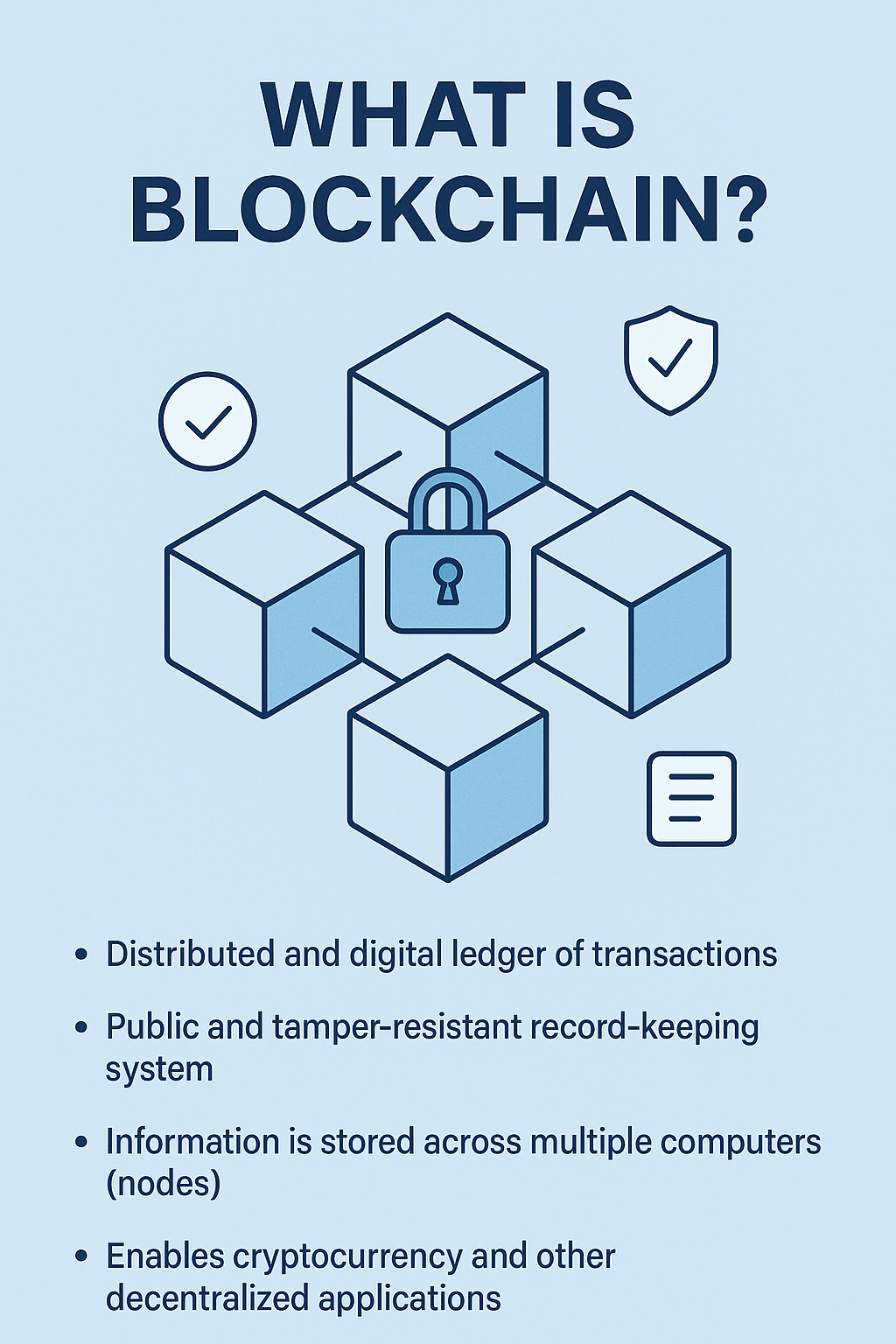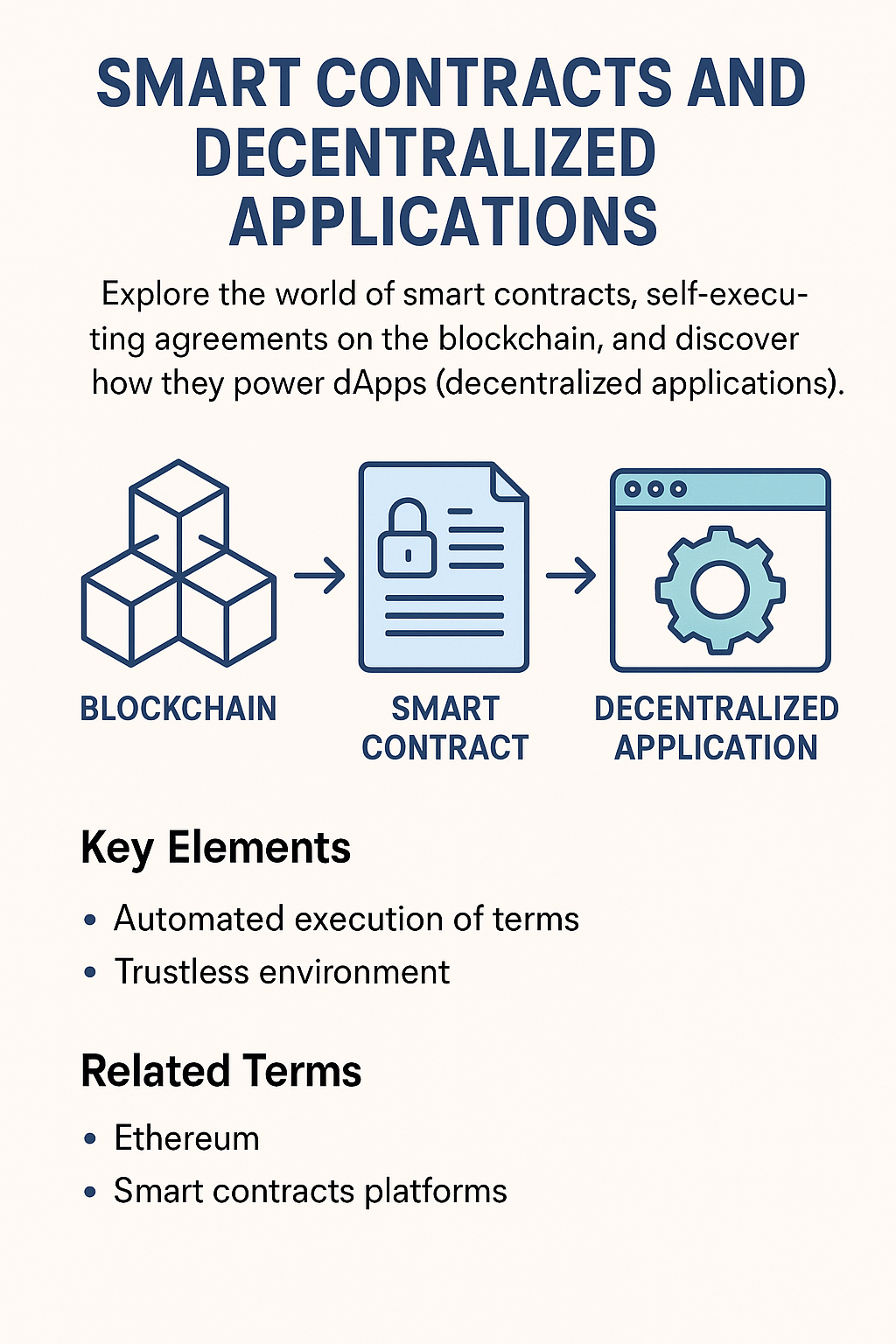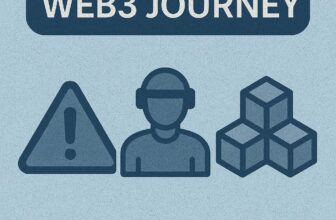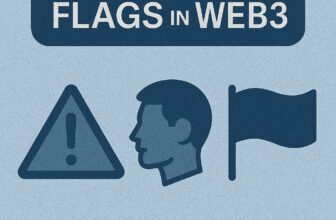Blockchain Explained Course – Intermediate Concepts in Crypto
Blockchain Explained Course
Welcome to our in-depth blockchain course, designed for learners ready to build on the basics and explore how blockchain truly functions. You’ll move beyond the basics and start thinking like a blockchain-native. This course is ideal for learners who have completed the "Crypto Basics Course" or already grasp the fundamentals.
-
Level
Intermediate
-
Duration
2–3 hours total
-
Lessons
10
-
Categoty
Crypto Fundamentals
-
Status
✅ Completed
📖 Lesson 1: How Does Blockchain Work Under the Hood?
This blockchain course starts with a deep dive into how blockchain works under the hood, demystifying decentralization and immutability.
🔍 Overview:
Unpack the inner workings of blockchain systems and understand what makes them trustless, tamper-resistant, and decentralized.
🧠 Learning Objectives:
- Grasp how data is structured and linked across blocks.
- Learn about consensus protocols and validation.
- Understand how immutability is achieved.
📝 Content:
Blockchain is not just a buzzword—it’s a layered system built from cryptographic principles, distributed computing, and consensus governance. Each block contains transactional data, a timestamp, and a cryptographic hash that links it to the previous block, forming a secure chain.
Blockchain’s trustless nature relies on consensus mechanisms — the protocols that allow distributed nodes to agree on a single version of the truth. While we’ve touched on this briefly, these mechanisms such as Proof of Work (PoW) and Proof of Stake (PoS) play a crucial role in maintaining blockchain integrity. To fully grasp how decentralization works, we’ll explore these concepts more deeply in our advanced courses.
Popular consensus algorithms include:
- Proof of Work (PoW) – Used by Bitcoin; involves miners solving complex puzzles
- Proof of Stake (PoS) – Used by Ethereum post-merge; validators are selected based on staked assets
The decentralized nature ensures no single point of failure, and any attempt to alter past data would require massive computational control over the network.
✨ Key Elements:
- Hashing
- Distributed ledger
- Block structure
- Consensus (PoW, PoS)
 Related Terms:
Related Terms:
Blockchain, Hash, Proof of Work, Proof of Stake, Distributed Ledger
🔍 Overview:
Explore how Bitcoin and Ethereum function under the surface, and how their purposes and mechanisms differ.
🧠 Learning Objectives:
-
Compare the architecture of Bitcoin vs. Ethereum
-
Understand key differences: consensus, scripting, scalability
-
Learn about Ethereum’s smart contract functionality
📝 Content:
Bitcoin is primarily a peer-to-peer digital currency with a narrow focus: secure, decentralized money. It uses Proof of Work and has limited scripting abilities.
Ethereum, on the other hand, is a full-featured blockchain with a Turing-complete language, enabling decentralized applications (dApps) and smart contracts.
Key Comparisons:
-
Bitcoin: Security-first, deflationary, slow but robust
-
Ethereum: Programmable, flexible, evolving (e.g., ETH 2.0)
Ethereum’s shift from PoW to PoS represents one of the largest protocol changes in blockchain history, significantly impacting energy use and scalability.
✨ Key Elements:
- Bitcoin vs Ethereum design
- Blockchain infrastructure
- Consensus differences
 Related Terms:
Related Terms:
Bitcoin, Ethereum, Smart Contracts, Scalability, PoW, PoS
🔍 Overview:
Move beyond just using wallets—learn how wallets interact directly with blockchain networks.
🧠 Learning Objectives:
-
Learn how wallets broadcast transactions to the blockchain
-
Understand gas fees, nonce, and network confirmations
-
Discover how multi-chain wallets work
📝 Content:
A wallet is your portal to the blockchain. When you send a transaction, your wallet constructs and signs it with your private key, broadcasting it to the network.
Important concepts:
-
Gas Fees: Required to incentivize miners/validators
-
Nonce: Ensures transactions are processed in order
-
Confirmations: How many blocks have passed since inclusion
Advanced wallets like MetaMask allow you to manage multiple networks (Ethereum, BNB Chain, Polygon) through custom RPC endpoints.
✨ Key Elements:
- Public/Private Keys
- Transaction broadcasting
- Wallet types
 Related Terms:
Related Terms:
Wallet, Transaction, Gas Fee, Blockchain Network, Multi-chain
🔍 Overview:
Go beyond wallet safety. Understand the security mechanisms of blockchains and how to protect yourself from network-level threats.
🧠 Learning Objectives:
-
Learn about 51% attacks, double-spending, and Sybil resistance
-
Understand common dApp vulnerabilities
-
Identify safe blockchain behaviors
📝 Content:
Blockchain networks aren’t immune to threats. Even with cryptographic security, vulnerabilities can arise from poor user practices, smart contract bugs, or network weaknesses.
Examples:
-
51% Attack: When one entity controls majority of hash power (common concern in small networks)
-
Double Spending: Attempting to use the same funds twice
-
Sybil Attacks: Creating multiple fake identities to gain influence
Best practices include using hardware wallets, verifying smart contracts, and double-checking on-chain addresses.
✨ Key Elements:
- Network threats
- Security best practices
- Consensus vulnerabilities

Blockchain Security, 51% Attack, Sybil Attack, Smart Contract Bugs, Safety
🔍 Overview:
One of the most debated topics in any blockchain course is governance—who makes decisions, how they're implemented, and how it impacts decentralization.
Understand who makes decisions in blockchain ecosystems—and how governance affects decentralization.
🧠 Learning Objectives:
-
Compare on-chain and off-chain governance
-
Explore examples from Ethereum, Polkadot, and DAOs
-
Assess the benefits and challenges of community-driven control
📝 Content:
Governance defines how changes are made to a blockchain's protocol. Some networks rely on off-chain discussions and core developer decisions (e.g., Bitcoin), while others enable on-chain voting by token holders (e.g., Polkadot, MakerDAO).
DAOs (Decentralized Autonomous Organizations) are a major innovation—allowing stakeholders to submit and vote on proposals directly.
Key trade-offs:
-
Speed vs. decentralization
-
Expert-led vs. community-led decisions
Effective governance balances these dimensions to foster innovation and prevent centralized control.

🔍 Overview:
Explore how blockchain networks scale to handle more users, faster transactions, and complex applications.
🧠 Learning Objectives:
-
Learn the challenges of blockchain scalability
-
Understand Layer 1 vs. Layer 2 solutions
-
Discover real-world examples: Optimism, Arbitrum, Polygon
📝 Content:
Scalability is one of blockchain’s biggest hurdles. High demand can cause slow transactions and high fees. Solutions are being implemented at different layers:
-
Layer 1: Improving the base protocol (e.g., Ethereum's sharding)
-
Layer 2: Building on top of the base layer (e.g., rollups like Optimism, zkSync)
-
Sidechains: Independent blockchains connected via bridges
Each solution aims to increase throughput while maintaining decentralization and security—the infamous blockchain trilemma.
✨ Key Elements:
- Scalability layers
- Throughput improvements
- Rollups and sidechains

Layer 2, Rollup, Arbitrum, Polygon, Scalability
🔍 Overview:
Oracles serve as vital bridges between blockchains and the external world. This lesson explores how smart contracts fetch off-chain data and why reliable oracle mechanisms are crucial for decentralized ecosystems.
🧠 Learning Objectives:
- Define what blockchain oracles are and why they matter
- Examine leading oracle providers like Chainlink, Band Protocol, and UMA
- Understand the risks of centralization, latency, and data manipulation
- Explore key oracle use cases: DeFi pricing, weather data, identity verification
📚 Content:
Smart contracts automate workflows without intermediaries. Written in code, they live on-chain and trigger based on specific conditions. They are integral to dApps like DEXs, lending platforms, and DAOs. Oracles extend their utility by feeding real-world data, such as price feeds, weather reports, or identity checks.
Popular oracles like Chainlink and Band Protocol use decentralized networks of data sources to maintain integrity. Still, oracles face issues like latency, manipulation, and single-point failures if not implemented properly.
Combined, smart contracts and oracles allow blockchain applications to become dynamic and context-aware, bridging the gap between code and reality.
✨ Key Elements:
- Off-chain data feeds
- Oracle network decentralization
- External APIs
- Oracle manipulation risks
 Related Terms:
Related Terms:
Oracles, Chainlink, UMA, Data Feeds, Off-chain Data, Price Feeds
🔍 Overview:
Understand how smart contracts automate trustless operations and power DeFi, NFTs, and more.
🧠 Learning Objectives:
- Learn how smart contracts work on Ethereum and other blockchains
- Explore common use cases and languages (e.g., Solidity)
- Discover real-world examples (DEXs, DAOs, NFTs)
📚 Content:
Smart contracts are the self-executing digital agreements that enable decentralized protocols to function without intermediaries. This lesson dives into how smart contracts are deployed on networks like Ethereum, and how they’re used in DeFi, NFTs, and beyond.
You’ll explore:
-
How Solidity is used to code contracts
-
The role of Ethereum Virtual Machine (EVM)
-
Common smart contract bugs and exploits
-
Live smart contracts on platforms like Uniswap, Compound, and OpenSea

Blockchain Course
✨ Key Elements:
- Code automation
- Smart contract language
- dApp integrations

Smart Contract, Solidity, DAO, dApp, Trustless
🔍 Overview:
Explore how decentralized applications (dApps) are transforming industries like finance, gaming, and identity.
🧠 Learning Objectives:
-
Understand the architecture of dApps
-
Examine the differences from traditional apps
-
Explore examples like Uniswap, Aave, Lens, and more
📚 Content :
dApps represent a shift away from centralized platforms, enabling user-owned and censorship-resistant software. This lesson walks you through their structure, how users interact with them, and where they are thriving.
You’ll discover:
-
Differences between dApps and Web2 apps
-
Smart contracts as backend logic
-
Wallet-based authentication
-
Notable examples in finance (Uniswap), social (Lens), and gaming (Axie Infinity)
✨ Key Elements:
- Decentralized frontend/backend
- Web3 integrations
- Wallet connectivity

dApp, Web3, DeFi, Uniswap, Aave
🔍 Overview:
Investigate how blockchain is disrupting sectors like supply chains, healthcare, art, and voting systems.
🧠 Learning Objectives:
-
Identify practical non-financial use cases of blockchain
-
Review government, enterprise, and public-sector integrations
-
Learn about current limitations and future potential
📚 Content:
Blockchain’s real-world utility spans far beyond cryptocurrencies. This lesson explores how decentralized technology is improving transparency, reducing fraud, and enabling innovation in legacy systems.
In this lesson:
-
Examine blockchain in supply chain logistics (e.g., IBM Food Trust)
-
Study its role in digital identity and academic credentials
-
Learn about use in land registries, voting, and carbon credits
By the end of this blockchain course, you’ll understand how blockchain technology is applied across real industries like supply chains, healthcare, and more.
✨ Key Elements:
- Real-world adoption
- Sector-specific examples
- Government use cases

Blockchain Adoption, Supply Chain, Healthcare, Digital Identity, e-Voting
📌 Conclusion
By the end of this blockchain course, you’ll have developed a solid intermediate understanding of blockchain technology—how it works, how it scales, how it connects to the real world, and how it drives decentralized applications. This foundation will help you interact more intelligently with crypto products and explore further topics like DeFi and smart contract development.
Featured Courses
Capstone: Simulated Web3 Journey
Managing Risks & Red Flags in Web3
Privacy & Transaction Optimization
Using Crypto in Daily Life
NFTs & Web3 Apps in Practice
Introduction to DeFi: Lending, Staking & Yield Explained
Understanding Block Explorers in Crypto
Bridges & Multi-Chain Navigation
Swapping Tokens & Using DEXs
What Our Learners Say
🚀 What's Next?
Are you ready to take your crypto knowledge to the next level? While this blockchain course forms a key part of your journey with Crypto Hoopoe Academy, there’s more ahead. For example, you can dive into upcoming courses like "DeFi Essentials" or "Security & Safety in Crypto" to expand your understanding even further. Additionally, subscribing to our newsletter or YouTube channel gives you access to expert explainers, hands-on tutorials, and timely blockchain insights.
Start Learning DeFiJoin the Crypto Hoopoe Community








